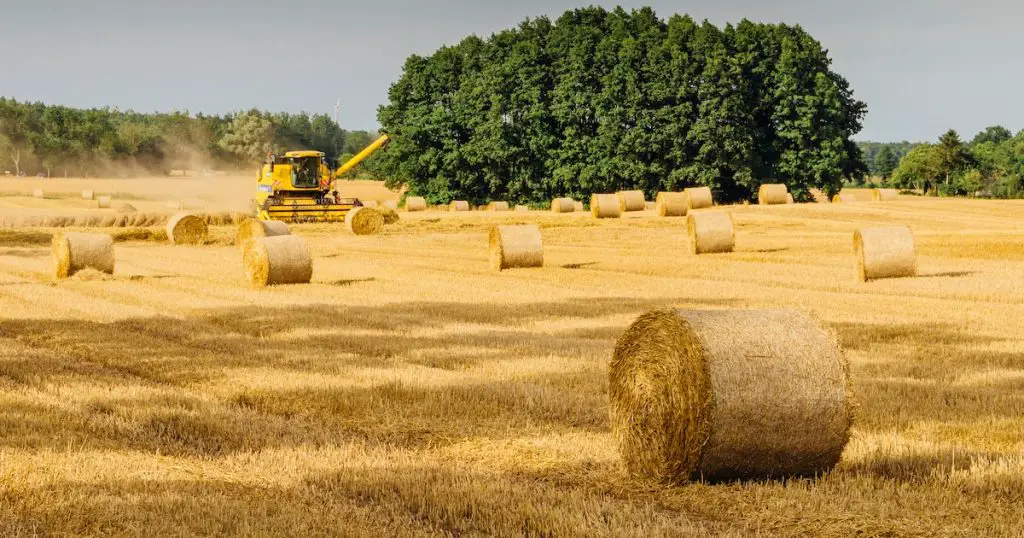Nestled in the heart of Arizona, Prescott’s charm extends beyond its historical landmarks to its unique climate. Many wonder about the influence of Prescott’s climate on agriculture. This climate, impacted by altitude, precipitation, and other factors, plays a pivotal role in shaping the agricultural practices of the region.

Understanding this interplay provides insights into the resilience and innovations of Prescott’s farming community.
The Distinctive Climate of Prescott
The climate in Prescott is quite distinctive, characterized by a blend of mild seasons and unique geographical features that influence weather patterns. With its relatively high elevation and proximity to mountainous terrain, the area experiences a range of climatic conditions.
Summers are warm but not unbearably hot, allowing for extended growing seasons, while winters are typically mild with occasional snowfall, affecting both crop selection and livestock management.
These climatic features have played a significant role in shaping the agricultural profile of Prescott, providing opportunities for a diverse array of farming activities. It’s a climate that demands adaptability, but also one that offers rich rewards for those who can navigate its intricacies.
Averages and Extremes: Temperature and Precipitation
Prescott experiences a temperate climate characterized by mild winters and warm summers. The average temperature rarely exceeds 90°F in summer or falls below 25°F in winter, as reported by the National Weather Service. However, precipitation patterns can be unpredictable.
Rainfall can vary dramatically from year to year, sometimes leading to drought conditions as highlighted by the United States Drought Monitor.
Situated at over 5,000 feet above sea level, Prescott’s elevation significantly influences its climate. Cooler temperatures and relatively low humidity levels can be attributed to its high-altitude positioning. The US Geological Survey suggests that areas at higher altitudes, like Prescott, tend to have cooler temperatures, affecting both daily life and agriculture.
The Historical Roots
The history of agriculture in Prescott is deeply intertwined with the region’s climatic conditions, painting a fascinating portrait of adaptation and growth. Early settlers quickly recognized the potential of the land, but also the limitations imposed by the climate.
From the Native American tribes that first cultivated maize and beans to the arrival of European settlers bringing new farming techniques and crop types, the relationship between the land and its people has been continually shaped by climatic variables.
Over the years, advances in technology and agricultural practices have allowed farmers to better adapt to the seasonal changes and occasional extremes that the Prescott climate can offer.
This historical perspective provides invaluable insights into how the region’s agriculture has evolved and adapted over time, always in concert with the ever-present influence of the climate.
Agriculture in Early Prescott: The Beginnings
From the time of early settlers, Prescott’s fertile land and temperate climate made it suitable for various agricultural activities. The region became known for its wheat and barley fields, vital for the settlers’ sustenance.
Historical records from the Prescott Historical Society highlight how early farmers adapted to the area’s climate and made the most of the resources at their disposal.
Adapting to the Climate: Indigenous Farming Techniques
Before the settlers, the indigenous peoples of Prescott practiced their unique farming techniques. They cultivated crops like maize, beans, and squash, using dry farming methods to conserve water.
These methods, discussed extensively at the Smithsonian National Museum of the American Indian, showcase the indigenous peoples’ deep understanding of the land and its climate.
Seasonal Impacts on Farming
Seasonal fluctuations in Prescott play a significant role in shaping the agricultural calendar and farming activities. The spring season often brings abundant rainfall, offering an ideal setting for planting a variety of crops, while summer’s warmer temperatures require careful water management and crop selection to prevent drought stress.
Autumn is typically a time for harvesting and preparing the soil for winter, which can present its own set of challenges like frost and reduced daylight hours. Farmers employ various techniques such as crop rotation and cover cropping to navigate these seasonal changes.

Seasonal impacts on livestock farming are also notable, as feeding and shelter requirements change with the weather. Overall, understanding and adapting to the seasonal nuances of Prescott’s climate is crucial for successful farming in the region.
Winter: Challenges and Opportunities
Winters in Prescott are usually mild but can occasionally usher in frosty conditions. These colder temperatures pose a risk to certain crops but offer a dormant period for others. According to the Farmers’ Almanac, this period is crucial for many fruit-bearing trees that require a specific number of chill hours to produce fruit in the subsequent season.
On the flip side, winter is also the season to plant hardy vegetables like kale, broccoli, and spinach that thrive in cooler conditions.
Spring: The Awakening of the Agricultural Landscape
As winter fades, the warming soils of spring beckon a new cycle of growth. The rise in temperatures and a gradual increase in daylight hours provide the ideal setting for seed germination. Crops like lettuce, radishes, and peas are commonly sown in this season.
Yet, spring also brings the threat of late frosts. The University of Arizona’s Cooperative Extension offers guidance on frost protection measures, emphasizing the importance of monitoring local forecasts and using protective covers.
Summer: Harnessing the Warmth and Overcoming Drought
Summer in Prescott, with its longer daylight hours, is a boon for photosynthesis, driving rapid growth in many plants. However, this season can sometimes escalate into drought conditions, as observed by the Water Resources Research Center.
Effective water management becomes paramount, with farmers resorting to drip irrigation and other water conservation techniques.
Autumn is a bustling time for Prescott farmers. It’s the season of harvest for many summer-planted crops. The cooling temperatures also make it ideal for planting winter crops. As the Arizona Farm Bureau notes, it’s a time for reflection, understanding what worked in the past growing season, and planning for the next.
Crops Thriving in Prescott’s Climate
The climate in Prescott offers a unique palette for agricultural cultivation, allowing a diverse array of crops to thrive. Cooler temperatures and well-distributed rainfall create ideal conditions for root vegetables like potatoes and carrots, as well as leafy greens such as lettuce and spinach.
Additionally, certain fruits like apples and cherries find the climate particularly hospitable. Seasonal variations also allow for the growth of specialty crops, which are well-suited to the microclimates within the region.
This crop diversity is not just a boon for farmers looking for multiple revenue streams, but also enriches the local cuisine and markets, creating a vibrant and dynamic agricultural landscape influenced directly by the climate.
Grains and Cereals: Wheat, Oats, and More
Grains, particularly wheat and oats, have historically been staple crops in Prescott. They are well-suited to the temperate climate, with varieties designed to withstand both the summer heat and winter chill.
Studies from the Agricultural Research Service have highlighted the adaptability of these grains to Prescott’s climate, making them a reliable crop choice.
Fruits and Berries: Apples, Grapes, and Their Adaptations
Prescott’s elevation and temperate climate have made it a favorable location for growing certain fruits, especially apples and grapes. The area’s vineyards, as outlined by the Arizona Wine Growers Association, have gained recognition for producing exceptional wines.
Additionally, local apple orchards often produce varieties that are uniquely flavorful, attributed to the region’s distinct climate.
Vegetables: From Roots to Greens
While Prescott’s climate can be challenging, it’s conducive for a wide variety of vegetables. Root vegetables like carrots, beets, and radishes do well in cooler months, while leafy greens such as spinach and lettuce thrive in the transitional seasons.
The Arizona Community Farmers Markets often showcase this seasonal bounty, reflecting the region’s rich agricultural diversity.
Livestock Farming and Climate Considerations
In Prescott, livestock farming is intrinsically linked to the climate, which shapes everything from grazing patterns to animal health. The cooler temperatures allow animals like cattle and sheep to graze outdoors for extended periods, thereby affecting pasture management strategies.
However, the climate also poses challenges; sudden shifts can result in health issues such as pneumonia in colder conditions or heat stress during warmer periods. Consequently, local farmers often rely on comprehensive strategies and guidelines for animal care, nutrition, and shelter to mitigate these climate-related challenges.
Ultimately, the climate serves as both an enabler and a constraint in livestock farming, requiring a nuanced approach for optimal animal well-being and productivity.
Grazing Patterns and Pasture Management
In Prescott, the cool climate allows livestock like cattle and sheep to graze outdoors for longer periods. Grazing animals feed on the lush pastures that thrive in temperate conditions.

However, as pointed out by the American Grassfed Association, managing grazing patterns is essential to ensure pastures aren’t overgrazed, allowing them to regenerate and provide continuous feed.
Animal Health: Addressing Climate-Related Concerns
While Prescott’s climate is generally favorable for livestock, sudden changes can pose health risks. Prolonged cold or wet conditions can lead to illnesses like pneumonia, while hotter periods increase the risk of heat stress.
Resources from the Livestock Conservancy emphasize the importance of providing adequate shelter, ensuring proper nutrition, and routinely monitoring the health of the livestock to combat these climate-related challenges.
Sustainable Farming in Prescott’s Climate
The concept of sustainable farming has found a receptive audience in Prescott, largely due to the region’s unique climate. The temperate conditions allow for a focus on organic farming methods that are not only eco-friendly but also adaptable to local climatic nuances.
Water conservation techniques, often advocated by local agricultural bodies, become especially relevant during drier periods, helping to save both water and soil. Additionally, the looming specter of climate change has inspired a proactive approach to future-proofing agricultural practices.
In summary, Prescott’s climate offers both a challenge and an opportunity to explore sustainable farming in a way that is harmonious with the land and beneficial for future generations.
The Rise of Organic Farming
Organic farming, which focuses on using natural processes and materials, is gaining traction in Prescott. The practices help preserve the soil’s health and increase its resilience against climatic variations. Organic Farming Research Foundation highlights how organic methods, when aligned with local climate conditions, can lead to healthier produce and ecosystems.
Water conservation is crucial, especially during the drier months. Techniques like rainwater harvesting, mulching, and drip irrigation are often recommended by institutions like the Natural Resources Conservation Service. These methods ensure that soil retains moisture, reducing the need for frequent watering.
Adapting to Climate Change: Future-Proofing Agriculture
Climate change poses unpredictable challenges. Prescott farmers are now seeking ways to adapt and future-proof their practices.
This involves selecting drought-resistant crop varieties, optimizing irrigation systems, and utilizing technology to monitor and respond to climate variations, as recommended by the Climate Adaptation Knowledge Exchange.
Economic Impact of the Climate on Prescott’s Agriculture
The climate’s influence on agriculture in Prescott has significant economic ramifications, shaping everything from crop yields to market prices. Seasonal variations and unpredictable weather events can either bolster or diminish agricultural output, creating a ripple effect on local and even national economies.
Government programs aim to cushion these climatic impacts through subsidies and other support mechanisms. Ultimately, the interplay between climate and agriculture in Prescott is a crucial factor that underpins the region’s economic vitality, affecting not just farmers but the broader community as a whole.
Crop Yield Variations and Market Prices
Crop yields in Prescott can fluctuate based on climatic conditions. A particularly dry year might reduce output, leading to a surge in market prices. Conversely, a year with optimal climatic conditions could see a bumper harvest. Insights from the U.S. Department of Agriculture provide a detailed analysis of these patterns and their economic implications.
Recognizing the vulnerabilities of farming to climatic events, government bodies offer subsidies and support programs. These programs, detailed on the Arizona Department of Agriculture’s website, aim to cushion farmers against potential losses due to unforeseen climatic disruptions and to promote sustainable farming practices.
Education and Research on Prescott’s Agriculture
The role of education and research in Prescott’s agriculture is pivotal for its sustained growth and adaptation to climate variables. Agricultural institutions and research centers in the region are instrumental in advancing scientific knowledge tailored to local needs.
From hands-on agroecology programs at colleges to ongoing research on optimal crop varieties, educational efforts ensure that Prescott’s farmers are well-equipped to navigate the challenges and opportunities presented by the region’s unique climate.
Workshops and training programs further enrich this educational landscape, providing practical skills and up-to-date information for the farming community.
Agricultural Institutions and Their Role
Several esteemed institutions play an integral role in advancing agricultural knowledge in the Prescott region. Institutions like Prescott College’s Agroecology Program provide hands-on experiences and valuable insights into sustainable farming practices tailored to the region’s unique climate.
One of the essential aspects of ensuring agricultural success in Prescott is to find crop varieties that are best suited for the region’s climate. Research initiatives by organizations like the Southwest Research and Extension Center focus on this aspect, continually testing and recommending varieties that can thrive in Prescott’s conditions.
Training and Workshops for Farmers
Staying updated with the latest farming techniques and practices is pivotal for any farmer. Several local organizations and colleges offer workshops, training programs, and seminars.
These platforms, such as those provided by the Yavapai County Cooperative Extension, equip farmers with the necessary knowledge and skills to navigate the ever-changing climatic challenges.
The Cultural Impact of Prescott’s Climate on Agriculture
The influence of Prescott’s climate on agriculture extends beyond mere crops and livestock; it deeply enriches the cultural fabric of the region. From agricultural festivals that celebrate the bounty of the land to culinary traditions that rely on locally sourced produce, the climate has shaped the way people in Prescott live, celebrate, and even eat.
Even the arts are influenced, as local galleries often feature works inspired by the breathtaking farmlands and the varying seasons. In essence, the climate’s impact on agriculture in Prescott is a central thread in the tapestry of the community’s cultural identity.
Agricultural Festivals and Celebrations
Prescott is home to several festivals that celebrate its agricultural heritage. The Prescott Farmers Market Harvest Festival is one such event that brings the community together, celebrating the bounties of the season and the hard work of local farmers.
The food culture in Prescott is deeply influenced by the crops grown in its fertile lands. Local eateries and chefs often source fresh produce directly from farms, ensuring that the region’s agricultural essence is reflected in its culinary delights. Websites like Taste of Prescott offer glimpses into these farm-to-table stories.

The scenic beauty of Prescott’s farms, coupled with the rhythmic changes of its seasons, has inspired many artists and writers. Local galleries and bookstores abound with works that capture the essence of life on the farm, shaped by the gentle hand of Prescott’s climate.
FAQs:
In this section, we will be delving into some of the most common inquiries and curiosities that surround our topic.
How does Prescott’s climate compare to nearby regions?
Prescott’s climate, largely due to its altitude, is cooler and more temperate than many of its neighboring regions in Arizona. While Phoenix might experience scorching summers, Prescott remains relatively mild, making it favorable for diverse agricultural practices.
Farmers in Prescott often grapple with unpredictable precipitation patterns, occasional droughts, and the threat of late frosts during spring, which can potentially damage budding crops.
Are there specific crops that can’t thrive in Prescott due to its climate?
While Prescott’s climate is versatile, it might not be ideal for tropical crops like bananas or citrus fruits, which require consistent warmth and specific humidity levels.
How is climate change expected to impact Prescott’s agricultural future?
Climate change may lead to more extreme weather events, longer drought periods, and unpredictable precipitation patterns. While this poses challenges, Prescott’s farmers are actively seeking adaptive techniques to navigate these changes.
Conclusion
Prescott’s enchanting climate, with its seasonal variations, plays a starring role in the region’s agricultural narrative. The dance between the land, the weather, and the farmer is a testament to human adaptability and nature’s enduring rhythms.
By understanding and respecting this delicate balance, Prescott’s farming community continues to thrive, feeding souls and connecting past, present



Leave a Comment
You must be logged in to post a comment.